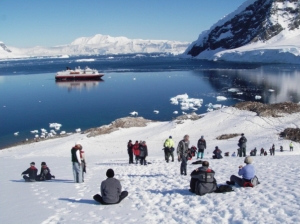Did you know that more and more tourists are going to Antarctica?Cruises to Antarctica have become increasingly popular in recent years, but tourism has side effects on the pristine and fragile environment.

In the past couple decades, Antarctic tourism has exploded to become the most common human activity on the continent. Cruise ships usually operate in the areas south of the South Shetland Islands and the northern parts of the Antarctic Peninsula. Norwegian tour companies organise about 14% of cruise tourism and MS Fram, which flies the Norwegian flag, is one of the cruise liners the ply Antarctic waters. But it is not only cruises that attract tourists to Antarctica. The pristine and challenging terrain inspires expeditions and extreme sports such as mountaineering and skiing expeditions. Antarctic animals, cultural heritage sites and the distinctive scenery are important as providers of new sensations, but the sites that are visited most frequently are also the most vulnerable. Human travel in these areas can have a devastating effect on historic monuments, vegetation and animals. Accidents in recent years – boats running aground, shipwrecks – have shown that Antarctica is a challenging place for cruise tourism, and that far-reaching demands must be placed on companies that operate there. The Antarctic Treaty stipulates several forms of restrictions on tourism. These include limiting the size of ships to a maximum of 500 passengers that will go ashore, and no more than 100 of them may be ashore simultaneously. There must also be one guide per group of twenty passengers. In addition, only one ship may operate within an area at any given time. These regulations were implemented in an attempt to limit wear on vegetation and cultural heritage sites, and to minimise stress and disturbance of wildlife. |
South Pole 1911–2011 is an informational outreach project run by the Norwegian Polar Institute
Contact person:


